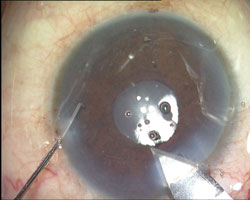Sulcus-implanted mirror telescopic IOL helpful for AMD, other macular disorders
The LMI-SI helps to improve visual results after cataract surgery with certain comorbidities.
 Amar Agarwal |
With an aging population, there is an increasing population of cataract patients with other associated eye diseases. The difficulties that comorbid pathologies induce are experienced by surgeons all over the world. The prevalence of age-related macular degeneration in Asia is similar to that in Caucasian populations, variously reported as ranging from 1.4% to 12.7% for early AMD and 0.2% to 1.9% for late AMD. The presence of cortical cataract and prior cataract surgery are significantly associated with increased prevalence of AMD, showing that these age-related conditions often coexist.
Dry AMD constitutes 85% to 90% of AMD patients, and most of these patients have no medical treatment other than vitamins and antioxidants. These patients can be treated only with optical means. Among wet AMD patients, only 10% to 15% can be assisted by medical treatment, and these go on to become the dry types, who then again need to be visually rehabilitated.
Despite successful cataract surgery in these patients, they do not benefit as much visually because of the coexisting retinal pathology. There is, therefore, a significant difference between treating the disease pathology with medical management, lasers or cataract surgery and being able to successfully rehabilitate the patient’s vision. Visual benefits from treatment are, after all, what is meaningful to the patient.
LMI-SI
Cataract surgery per se is not a problem in eyes with AMD, but lack of postop visual improvement is a cause of concern. Dr. Lipshitz designed the LMI-SI (OriLens), which is a telescopic lens working on the principle of using mirrors to magnify the central image while the peripheral field remains normal. The LMI-SI is positioned in the sulcus over a regular bag-implanted IOL. It is a telescopic IOL that magnifies the image on the central retina. It looks like a regular PMMA IOL and is 5 mm or 6 mm in diameter (loop diameter is 13.5 mm), and it contains loops that have a similar configuration as a regular IOL. However, the LMI-SI is thicker, with a central thickness of 1.25 mm. The first implantation of this lens was done by Prof. Agarwal.
As soon as a patient with AMD comes in, full medical and retinal eye exams are done, including slit lamp for evaluation of the cornea, iris, anterior chamber, lens and vitreous, fundus fluorescein angiography, optical coherence tomography, and IOP check.
The distance and near visual acuities are checked in each eye separately using the ETDRS chart with best correction. Best corrected distance and near visual acuities with 2.5× external telescope are again checked using the ETDRS chart. If a patient shows improvement with the external telescope, he or she is a good candidate for the LMI-SI. A cycloplegic refraction is also done. Specular microscopy is done for endothelial cell count. A-scan is performed for anterior chamber depth and IOL calculations. Keratometric readings are taken with the keratometer or with corneal topography.
Surgery for implanting the lens
Intraoperatively, anesthesia is given according to the surgeon’s preference. A corneal or limbal incision may be used, and the size of the incision is made according to the surgical technique. If the eye is phakic, a routine phaco or extracapsular cataract extraction is performed, and the IOL planned for the patient, with the power calculated according to biometry, is inserted into the capsular bag. The incision is then enlarged to 5 mm to 5.5 mm. The anterior chamber is filled with viscoelastic, and the implant is also coated with viscoelastic. It is then grasped by the loops or the base of the loop, taking care not to touch the lens optic itself. It is inserted into the sulcus as a piggyback IOL with the posterior mirror (ring shaped) pointing toward the surgeon. It is confirmed that the pupil on the operated eye is central. In case of an eccentric pupil, a pupilloplasty may be needed. A peripheral iridectomy is then done surgically (YAG laser should not be used). All the viscoelastic is removed, and the incision is sutured.
|
|
|
|
A conventional foldable IOL in the bag after
performing cataract surgery.
Images: Agarwal A |
|
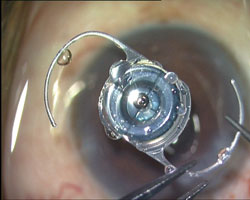 The LMI-SI is seen. |
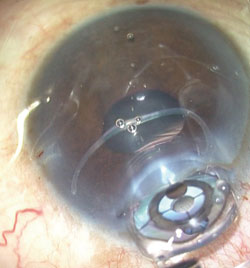 The LMI-SI has been coated with viscoelastic and inserted through the clear corneal incision, which has been extended just enough to allow implantation. |
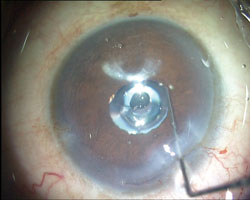 Photograph showing the LMI-SI well-centered with a clear cornea. |
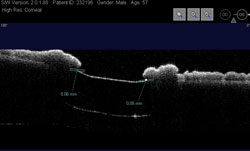 Anterior segment OCT showing the LMI-SI in the sulcus above the bag-implanted IOL. |
Postoperative care is similar to that of a regular cataract extraction except that a closer watch is kept for anterior synechiae and IOP spike. Postop tests are carried out at days 1, 2, 7 and 30 and at months 3, 6 and 12. The centration and position of the lens are checked, and the patient is refracted for distance and near uncorrected and best corrected visual acuities using ETDRS (each eye separately). Postoperative specular microscopy is done.
Results
Three patients were operated using this IOL, and the initial outcomes are encouraging. A trial with a larger number of patients and a longer follow-up is planned. As in other cases, proper patient recruitment is a key factor in ensuring good outcomes. The inclusion criteria for our pilot trial of the LMI-SI included patients with bilateral AMD (dry type, wet type or scar stage) or other similar macular lesions in which visual acuity ranged between 20/80 and 20/800 in each eye and improved for distance and/or near when tested with 2.5× magnification using an external telescope. Presence of any other systemic or ocular diseases, other than cataract/pseudophakia, AMD or another macular lesion, excluded them, as did any other previous eye surgery other than cataract. Only those patients who were easy to communicate with, were responsible, understood his or her condition, knew the risks and potential benefits involved, and were highly motivated to read and improve visual capabilities were included. They would have to be available for 1 year of postop follow-up. All the patients signed an informed consent. Patients whose fellow eye suffered from medical problems that would not enable the patient to use his or her peripheral vision, eg, those with glaucoma or retinitis pigmentosa, were excluded also.
Advantages of the lens
The LMI-SI can be implanted in both eyes, and it is surgeon friendly. It is a simple and safe surgery and can be performed by any cataract surgeon. It does not lie close to the corneal endothelium, and hence, chances of damage to the corneal endothelium are low. It also offers a quick recovery for patients who do not need prolonged and complicated postop training sessions for visual rehabilitation. It preserves part of the peripheral vision while magnifying the central field. It is also complementary to all other retinal treatments (injections, lasers, etc.) and can be used for other retinal diseases.
This IOL is placed in the sulcus over another IOL. A majority of AMD patients may have already undergone cataract surgery with IOL implantation. In such a case, it is still possible to offer the patient the opportunity of visual rehabilitation without having to undergo a complicated procedure such as explantation of the existing IOL and reimplantation of another telescopic device. The LMI-SI is placed in the sulcus, so surgery is simple. One-lens-fits-all; that is, the previously placed IOL in the bag takes care of the refractive error of the patient. Hence, the same LMI-SI can be offered to all patients regardless of the biometric calculation of IOL power.

- Amar Agarwal, MS, FRCS, FRCOphth, is director of Dr. Agarwal’s Eye Hospital and Eye Research Centre. Prof. Agarwal is the author of several books published by SLACK Incorporated, publisher of Ocular Surgery News, including Phaco Nightmares: Conquering Cataract Catastrophes, Bimanual Phaco: Mastering the Phakonit/MICS Technique, Dry Eye: A Practical Guide to Ocular Surface Disorders and Stem Cell Surgery and Presbyopia: A Surgical Textbook. He can be reached at 19 Cathedral Road, Chennai 600 086, India; fax: 91-44-28115871; e-mail: dragarwal@vsnl.com; website: www.dragarwal.com.
- Disclosures: Dr. Lipshitz has a financial interest in the LMI-SI (OriLens). Prof. Agarwal and Dr. Jacob do not have any financial interests in the products or companies mentioned in this article.


